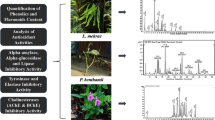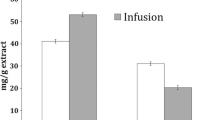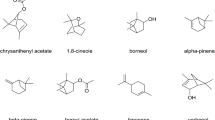Abstract
Onosma riedliana Binzet & Orcan, a traditionally used plant species, has been explored for its therapeutic potential in this study. The work presented here is the first report on the phenolic profile and biological activity of this species. Three extracts of varying polarity were prepared, with the methanolic extract containing the highest phenolic content (97.62 ± 0.20 mgGAE/g). Key phenolic compounds identified included pinoresinol, hesperidin, 4-hydroxybenzoic acid, and p-coumaric acid. The methanolic extract exhibited exceptional antioxidant properties, rivaling Trolox as a positive control, primarily attributed to hesperidin and luteolin. Moreover, the ethyl acetate extract demonstrated remarkable inhibition of cholinesterase and tyrosinase enzymes, while the methanolic extract displayed potent activity against carbohydrate hydrolytic enzymes, α-amylase and α-glucosidase. Again, phenolic compounds were shown to be responsible for the inhibition of cholinesterases and tyrosinase, but not for α-amylase and α-glucosidase. These findings underscore Onosma riedliana’s potential for incorporation into diverse pharmaceutical formulations, given its multifaceted bioactivity.
Similar content being viewed by others
Avoid common mistakes on your manuscript.
Introduction
Throughout history, medicinal and aromatic plants have played a crucial role in treating a wide range of disorders. Phenolic compounds are found to be the major carriers of plants therapeutic properties. Numerous studies have highlighted the protective role of plant phenolics in degenerative diseases, including cardiovascular issues, cancer, diabetes, inflammation, and more [1]. The Onosma genus comprises approximately 150 species distributed worldwide [2]. They predominantly thrive in arid, sun-drenched environments with rocky, sandy substrates, showcasing their resilience to heat and drought. Consequently, these species tend to accumulate higher levels of phenolic compounds, aiding their survival in challenging conditions [3]. Traditionally, Onosma species have been used to treat various disorders, including bronchitis, abdominal pain, fever, and skin burns. Additionally, they serve as a source of red dye from the roots, commonly employed to color food items, oils, and medicinal preparations [4]. Several Onosma species have undergone phytochemical analysis, revealing their richness in various phenolic compounds, particularly flavonoids like luteolin and hesperidin [5,6,7,8,9,10,11,12,13,14,15,16]. Continuing the phytochemical investigation of Onosma species, this study represents the first report on the phenolic profiles, antioxidant properties, and enzyme inhibitory activities of three extracts derived from Onosma riedliana. Although O. riedliana was initially described by Binzet and Orcan [2], it remains relatively unexplored in the literature. Given its membership in a genus with a rich history of therapeutic use, further phytochemical exploration is warranted to unlock its pharmaceutical potential.
Materials and Methods
The materials and methods section is presented as supplementary material.
Results and Discussion
Chemical Composition
The yields of extracts obtained from O. riedliana varied among the three solvents used, with the ethyl acetate extract yielding 2.03%, the methanolic extract 0.41%, and the aqueous extract 9.28%. The selection of solvents for extracting active compounds from medicinal and aromatic plants depends on several factors, including the plant type, the specific plant part to be extracted, and the nature of the bioactive compounds. To capture a broader spectrum of phenolic compounds, this study employed three solvents with varying polarities. As per the spectrophotometric assessments of total phenolic and flavonoid content in O. riedliana extracts (Fig. 1), the methanolic extract exhibited significantly higher levels of these compounds compared to the other two extracts. Specifically, the methanolic extract contained 97.62 ± 0.20 mg GAE/g of phenolic compounds and 54.98 ± 0.05 mg RE/g of flavonoids (Fig. 1). In comparison to other Onosma species, O. riedliana showcased similar levels of both phenolic and flavonoid compounds as O. aucheriana [18], yet significantly higher levels than in other species within the genus [5,6,7,8,9,10,11,12,13,14,15,16], where the total phenolic content did not exceed 70 mg GAE/g of extract.
The detailed phenolic composition of the plant extracts was analyzed using LC-MS/MS, and the results are summarized in Table 1. The predominant compound in both the ethyl acetate and methanolic extracts was the tetrahydrofuran lignan pinoresinol, with levels of 2992.0 ± 38.9 and 73628.2 ± 1256.9 μg/g of extract, respectively. This phenol, also found in some Brassicae vegetables, sesame seeds, and olives, possesses strong antioxidant [17] and hypoglycemic [18], and antibacterial properties [19]. It’s worth noting that while pinoresinol is present in other Onosma species, it is typically found at significantly lower levels. The aqueous extract contained the lowest amounts of flavonoids, whereas the methanolic extract was particularly rich in hesperidin, with a concentration of 32455.3 ± 27.7 μg/g. Hesperidin, primarily found in citrus species, also stood out as the main flavonoid in the ethyl acetate extract of O. riedliana (Table 1). Furthermore, other Onosma species, such as O. trapezuntea and O. rigidum [6], O. nana [7], O. papillosa [10], O. stenoloba [14], and O. mollis [16], have been found to contain significant levels of this flavonoid.
Antioxidant Activity
To assess the antioxidant potential of O. riedliana more comprehensively, various assays were employed, each based on distinct mechanisms of action. These included reducing stable molybdenum (phosphomolybdenum assay), ferric (FRAP assay), and cupric (CUPRAC assay) cations, as well as reducing stable radicals (DPPH and ABTS assays) and the ability to chelate ferrous ions. The results are summarized in Table 2 and expressed as IC50 values (mg/mL), indicating the concentration needed to scavenge, reduce, or chelate 50% of the potential oxidant. Among the O. riedliana extracts investigated, the methanolic extract exhibited the most potent antioxidant activity across all six assays. In many studies, different antioxidant assays relying on various reaction mechanisms can lead to challenging and inconsistent result interpretation and comparison. To address this issue, relative antioxidant capacity indices (RACI) have been introduced. These indices offer a numerical scale that integrates multiple chemical methods, enabling the comparison of antioxidant capacity without being limited to a specific mechanism. RACI values for the methanolic extract of O. riedliana are notably high (Table 2), falling within the range of the most potent antioxidant plant-based foods [20]. However, there are limited reports on RACI values for other Onosma species, which generally exhibited lower RACI values than O. riedliana. For instance, methanolic extracts of O. aucheriana, O. frutescens, and O. sericea had RACI values of -0.49, -0.34, and 0.89, respectively [13], while O. ambigens exhibited a value of 0.90 [14].
The correlation matrix, presented in Fig. 2, illustrates the relationships between the antioxidant activity of three O. riedliana extracts, and the levels of the most abundant phenolic compounds (> 100.00 μg/g) present in these extracts. Remarkably, all the phenolic compounds, with the exception of 2,5-dihydroxybenzoic and 3,4-dihydroxyphenylacetic acids, exhibited notably high correlations with both the radical scavenging assays and the assays related to reducing stable cations. When considering correlation data from other Onosma species, it becomes evident that flavonoids tend to yield higher Pearson correlation coefficients compared to phenolic acids. This suggests that flavonoids are primarily responsible for the extracts’ ability to scavenge free radicals and reduce stable cations. Among these compounds, luteolin and its glycoside, hesperidin, as well as quercetin, kaempferol, and apigenin, play pivotal roles in conferring antioxidant properties to the extracts [6, 8, 11,12,13, 15]. Therefore, flavonoid-rich extracts of O. riedliana could be used in the treatment of different degenerative diseases, such as cardiovascular and inflammatory disease, cataracts, and cancer [9, 11, 15].
Correlation matrix between antioxidant activity and the most abundant phenolic compounds in the extracts of Onosma riedliana
P-Mo, phosphomolybdenum assay; FeCH, ferrous ion chelating assay; PCATHA, protocatechuic acid; 34DHPA, 3,4-dihydroxyphenylacetic acid; CGA, chlorogenic acid; 25DHBA, 2,5-dihydroxybenzoic acid; 4HBA, 4-hydroxybenzoic acid; VA, vanillic acid; CA, caffeic acid; SyA, syringic acid; VAL, vanillin; pCA, p-coumaric acid; FA, ferulic acid; LUTG, luteolin-7-glucoside; HESP, hesperidin; RA, rosmarinic acid; HYPER, hyperoside; PINOR, pinoresinol; LUT, luteolin
Enzyme Inhibitory Activity
The exploration of O. riedliana’s potential as a source of enzymatic inhibitors aligns with the growing interest in natural remedies for different disorders and the development of safer and more sustainable treatment options. The results presented in Table 3 highlight the differential inhibitory activities of the three O. riedliana extracts against various enzymes. The ethyl acetate extract exhibited the lowest IC50 values for the inhibition of cholinesterases, α-amylase, and α-glucosidase, while the methanolic extract showed the most favorable outcomes in inhibiting tyrosinase. Additionally, the results are expressed as equivalents of positive probes used in these assays, such as galanthamine (mg GAL/g), kojic acid (mg KA/g), and acarbose (mg AC/g). In this context, the ethyl acetate extract displayed the highest values, except for the inhibition of tyrosinase. Similar findings were reported for O. tauricum var. tauricum [8], O. gigantea [11], and O. pulchra [11], where ethyl acetate extracts demonstrated superior activities against these enzymes. The Pearson correlation matrix between enzyme inhibitory activities and the most abundant phenolic compounds in O. riedliana extracts (Fig. 3) suggests that all flavonoids, including luteolin, luteolin-7-glucoside, hesperidin, and hyperoside, as well as phenolic acids (excluding 3,4-dihydroxyphenylacetic and 2,5-dihydroxybenzoic acids), exhibit a highly significant correlation with the inhibitory activity of the extracts against the enzyme tyrosinase. Furthermore, the results indicate that phenolic compounds are primarily responsible for the inhibition of the enzyme acetylcholinesterase but not for butyrylcholinesterase or the two carbohydrate hydrolytic enzymes, α-amylase and α-glucosidase. These findings align with previous studies by Baltaci et al. [5] and Sarikukcu et al. [14], which conducted docking analyses and found that flavonoids like hesperidin and hyperoside had strong binding activity for both cholinesterases and tyrosinase, while their activities were comparatively lower for other enzymes. To summarize, phenolic-rich plant extracts of O. riedliana showed pharmacological potential as inhibitors of enzyme cholinesterase, which activity is related with neurodegenerative diseases. Also, these extract could be used as natural plant-based tyrosinase inhibitors, that normally are used for the prevention of severe skin diseases [9, 11, 15].
Correlation matrix between enzyme inhibitory activity and the most abundant phenolic compounds in the extracts of Onosma riedliana
AChE, acetylcholinesterase inhibitory assay; BChE, butyrylcholinesterase inhibitory assay; TYR, tyrosinase inhibitory assay; AMYL, α-amylase inhibitory assay; GLUC, α‐glucosidase inhibitory assay; PCATHA, protocatechuic acid; 34DHPA, 3,4-dihydrohxyphenylacetic acid; CGA, chlorogenic acid; 25DHBA, 2,5-dihydroxybenzoic acid; 4HBA, 4-hydroxybenzoic acid; VA, vanillic acid; CA, caffeic acid; SyA, syringic acid; VAL, vanillin; pCA, p-coumaric acid; FA, ferulic acid; LUTG, luteolin-7-glucoside; HESP, hesperidin; RA, rosmarinic acid; HYPER, hyperoside; PINOR, pinoresinol; LUT, luteolin
Conclusions
This paper presents the first-ever exploration of the phenolic profiles and biological activities of three extracts derived from Onosma riedliana, a plant belonging to a genus with a long history of therapeutic use for diverse disorders. The primary phenolic compounds identified in these extracts include lignan pinoresinol, flavonoid hesperidin, and phenolic acids, specifically 4-hydroxybenzoic and p-coumaric acids. The antioxidant potential of Onosma riedliana was assessed using six distinct assays. The methanolic extract displayed the highest antioxidant potency against oxidative agents, primarily attributed to the presence of flavonoids such as hesperidin and luteolin. Additionally, the ethyl acetate extract demonstrated notable inhibitory activity against two enzymes, cholinesterase and tyrosinase, while the methanolic extract exhibited remarkable efficacy against two carbohydrate hydrolytic enzymes, α-amylase and α-glucosidase. Statistical analysis of the data suggests that phenolic compounds, particularly flavonoids, are responsible for the inhibition of cholinesterases and tyrosinase, though they do not influence α-amylase and α-glucosidase. In conclusion, the findings presented herein underscore the potential of Onosma riedliana as a valuable source of bioactive natural products. Its diverse array of compounds highlights its suitability for various pharmaceutical formulations, indicating its significance in the realm of herbal medicine and natural product-based therapeutics, mainly in the treatment of different neurodegenerative diseases.
Data Availability
The authors confirm that the data supporting the findings of this study are available within the article and its supplementary materials. Raw data are on request from the corresponding author.
References
Kumar N, Goel N (2019) Phenolic acids: natural versatile molecules with promising therapeutic applications. Biotechnol Rep 24:e00370. https://doi.org/10.1016/j.btre.2019.e00370
Binzet R, Orcan N (2007) A new species of Onosma (Boraginaceae) from Southern Turkey. Novon 17:8–10. https://doi.org/10.3417/1055-3177(2007)17[8:ANSOOB]2.0.CO;2
Naikoo MI, Dar MI, Raghib F, Jaleel H, Ahmad B, Raina A, Khan FA, Naushin F (2019) Role and regulation of plants phenolics in abiotic stress tolerance: an overview. In: Plant Signaling Molecules. Khan MIR, Reddy PS, Ferrante A, Khan NA. (Eds). Woodhead Publishing, pp. 157–168. https://doi.org/10.1016/B978-0-12-816451-8.00009-5
Kumar N, Kumar R, Kishore K (2013) Onosma L.: A review of phytochemistry and ethnopharmacology. Pharmacogn Rev 7:140–151. https://doi.org/10.4103/0973-7847.120513
Baltaci N, Aydogdu N, Sarikurkcu C, Tepe B (2021) Onosma gracilis (Trautv.) and O. oreodoxa (Boiss. & Heldr.): Phytochemistry, in silico docking, antioxidant and enzyme inhibitory activities. S Af J Bot 143:410–417. https://doi.org/10.1016/j.sajb.2021.03.022
Kirkan B, Sarikurkcu C, Zengin G (2022) Bioactive constituents, antioxidant effects and enzyme inhibitory properties of two Onosma species (Onosma Trapezuntea and O. Rigidum). S Af J Bot 145:142–148. https://doi.org/10.1016/j.sajb.2021.09.036
Kirkan B, Sarikurkcu C, Binzet R, Tepe B (2023) Two Onosma species (Onosma microcarpum and O. nana) as an alternative source of multifunctional agents: biological and phytochemical evaluation. Biointerface Res. Appl. Chem. 13:77. https://doi.org/10.33263/BRIAC131.077
Kirkan B, Sarikurkcu C, Ozer MS, Cengiz M, Atılgan N, Ceylan O, Tepe B (2018) Phenolic profile, antioxidant and enzyme inhibitory potential of Onosma tauricum var. tauricum. Ind Crop Prod 125:549–555. https://doi.org/10.1016/j.indcrop.2018.09.043
Saravanakumar K, Sarikurkcu C, Sahinler SS, Sarikurkcu RB, Wang M-H (2021) Phytochemical composition, antioxidant, and enzyme inhibition activities of methanolic extracts of two endemic Onosma species. Plants 10:1373. https://doi.org/10.3390/plants10071373
Saravanakumar K, Sarikurkcu C, Sarikurkcu RT, Wang M-H (2019) A comparative study on the phenolic composition, antioxidant and enzyme inhibition activities of two endemic Onosma species. Ind Crop Prod 142:111878. https://doi.org/10.1016/j.indcrop.2019.111878
Sarikurkcu C, Kirkan B, Ozer MS, Ceylan O, Atilgan N, Cengiz M, Tepe B (2018) Chemical characterization and biological activity of Onosma gigantea extracts. Ind Crop Prod 115:323–329. https://doi.org/10.1016/j.indcrop.2018.02.040
Sarikurkcu C, Sahinler SS, Ceylan O, Tepe B (2020) Onosma pulchra: phytochemical composition, antioxidant, skin-whitening and anti-diabetic activity. Ind Crop Prod 154:112632. https://doi.org/10.1016/j.indcrop.2020.112632
Sarikurkcu C, Sahinler SS, Tepe B (2020) Onosma aucheriana, O. frutescens, and O. sericea: phytochemical profiling and biological activity. Ind Crop Prod 154:112633. https://doi.org/10.1016/j.indcrop.2020.112633
Sarikurkcu C, Sahinler SS, Husunet MT, Istifli ES, Tepe B (2020) Two endemic Onosma species (O. sieheana and O. stenoloba): A comparative study including docking data on biological activity and phenolic composition. Ind Crop Prod 154:112656. https://doi.org/10.1016/j.indcrop.2020.112656
Sarikurkcu C, Sahinler SS, Ceylan O, Tepe B (2020) Onosma ambigens: phytochemical composition, antioxidant and enzyme inhibitory activity. Ind Crop Prod 154:112651. https://doi.org/10.1016/j.indcrop.2020.112651
Tlili N, Sarikurkcu RT, Ceylan O, Sarikurkcu C (2020) Onosma polyantha vs. Onosma mollis: analysis of phenolic compounds using liquid chromatography–electrospray ionization tandem mass spectrometry (LC-ESI-MS/MS) and assessment of the antioxidant activity. Anal Lett 1–12. https://doi.org/10.1080/00032719.2020.1803348
Bayram B, Esatbeyoglu T, Schulze N, Ozcelik B, Frank J, Rimbach G (2012) Comprehensive analysis of polyphenols in 55 extra virgin olive oils by HPLC-ECD and their correlation with antioxidant activities. Plant Foods Hum Nutr 67:326–336. https://doi.org/10.1007/s11130-012-0315-z
Zhou H, Ren J, Li Z (2017) Antibacterial activity and mechanism of pinoresinol from Cinnamomum camphora leaves against food-related bacteria. Food Control 79:192–199. https://doi.org/10.1016/j.foodcont.2017.03.041
Wikul A, Damsud T, Kataoka K, Phuwapraisirisan P (2012) (+)-Pinoresinol is a putative hypoglycemic agent in defatted sesame (Sesamum indicum) seeds though inhibiting α-glucosidase. Bioorg Med Chem Lett 22:5215–5217. https://doi.org/10.1016/j.bmcl.2012.06.068
Sun T, Tanumihardjo SA (2007) An integrated approach to evaluate food antioxidant capacity. J Food Sci 72:R159–R165. https://doi.org/10.1111/j.1750-3841.2007.00552.x
Funding
Open access publishing supported by the National Technical Library in Prague. This work was supported by the Ministry of Agriculture of the Czech Republic, institutional support MZE-RO0423.
Open access publishing supported by the National Technical Library in Prague.
Author information
Authors and Affiliations
Contributions
C.S., B.K., R.B., and S.S.S. performed formal analysis, C.S. and S.Ć.Z. prepared the figures, S.Ć.Z. wrote the original draft, P.T. reviewed and edited the manuscript. All authors have read and agreed to the published version of the manuscript.
Corresponding author
Ethics declarations
Ethical Approval and Consent to Participate
Not applicable.
Consent for Publication
Written informed consent for publication was obtained from all authors.
Competing Interests
The authors declare no competing interests.
Additional information
Publisher’s Note
Springer Nature remains neutral with regard to jurisdictional claims in published maps and institutional affiliations.
Electronic Supplementary Material
Below is the link to the electronic supplementary material.


Rights and permissions
Open Access This article is licensed under a Creative Commons Attribution 4.0 International License, which permits use, sharing, adaptation, distribution and reproduction in any medium or format, as long as you give appropriate credit to the original author(s) and the source, provide a link to the Creative Commons licence, and indicate if changes were made. The images or other third party material in this article are included in the article’s Creative Commons licence, unless indicated otherwise in a credit line to the material. If material is not included in the article’s Creative Commons licence and your intended use is not permitted by statutory regulation or exceeds the permitted use, you will need to obtain permission directly from the copyright holder. To view a copy of this licence, visit http://creativecommons.org/licenses/by/4.0/.
About this article
Cite this article
Ćavar Zeljkovıć, S., Sahinler, S.S., Sarikurkcu, C. et al. Exploring the Pharmacological Potential of Onosma riedliana: Phenolic Compounds and Their Biological Activities. Plant Foods Hum Nutr 79, 106–112 (2024). https://doi.org/10.1007/s11130-023-01131-0
Accepted:
Published:
Issue Date:
DOI: https://doi.org/10.1007/s11130-023-01131-0







